
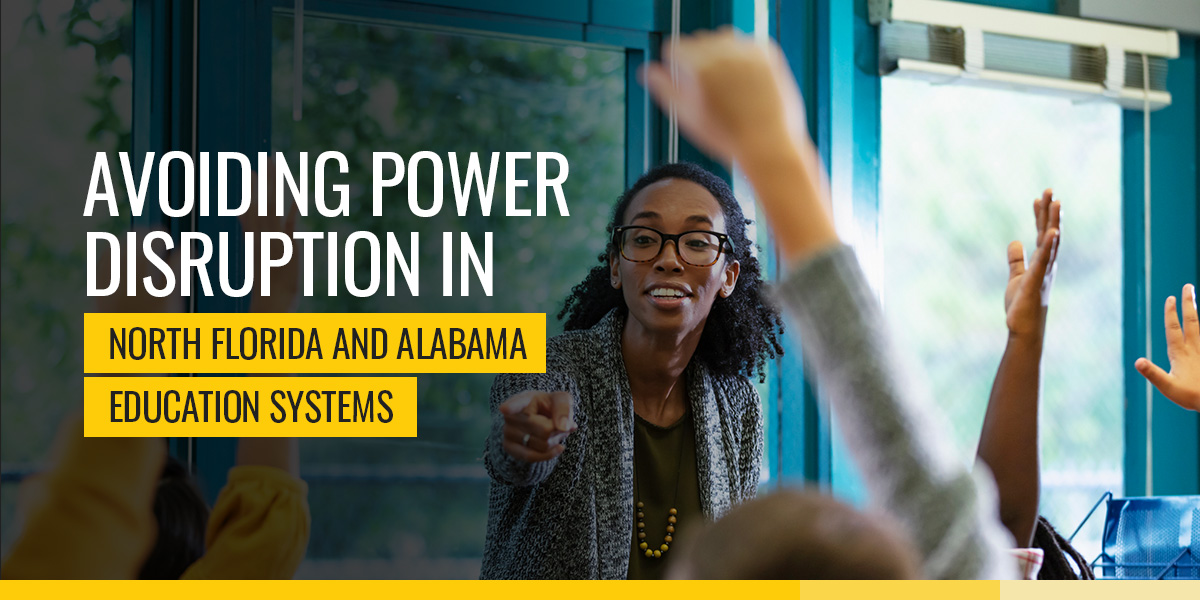
Severe weather conditions — such as hurricanes, ice storms, flooding, and heat waves — are the culprit of many of our nation’s power outages. A report from Climate Central shows that weather events and outages are growing in frequency. In the United States, there were 64% more major outages between 2011 and 2021 than in the previous decade.
If you work at an educational institution in Florida or Alabama, you likely know that weather and power outages have been an ongoing concern for decades. Power outages are a major disruption to the learning process. Additionally, they pose risks to public health and safety and put stress on the nation’s electrical infrastructure.
With weather-related outages growing more common across the U.S., knowing how to prepare and respond is essential. Learn about the importance of backup power for schools and what you can do to prepare your educational center for outages.
According to Climate Central, extreme weather events in the U.S. caused 83% of major power outages between 2000 and 2021. Here are the primary factors responsible for these outages:
The Southeast, Northeast, and Midwest saw the most weather-related outages during this period. Southeastern states experienced the highest number of major power outages. Below are the main weather variables contributing to outages in two Southeastern states — Florida and Alabama.
Alabama is no stranger to tornadoes, high winds, hurricanes, hail, extreme heat, and occasional winter weather events. The state has experienced more of these conditions since the turn of the century.
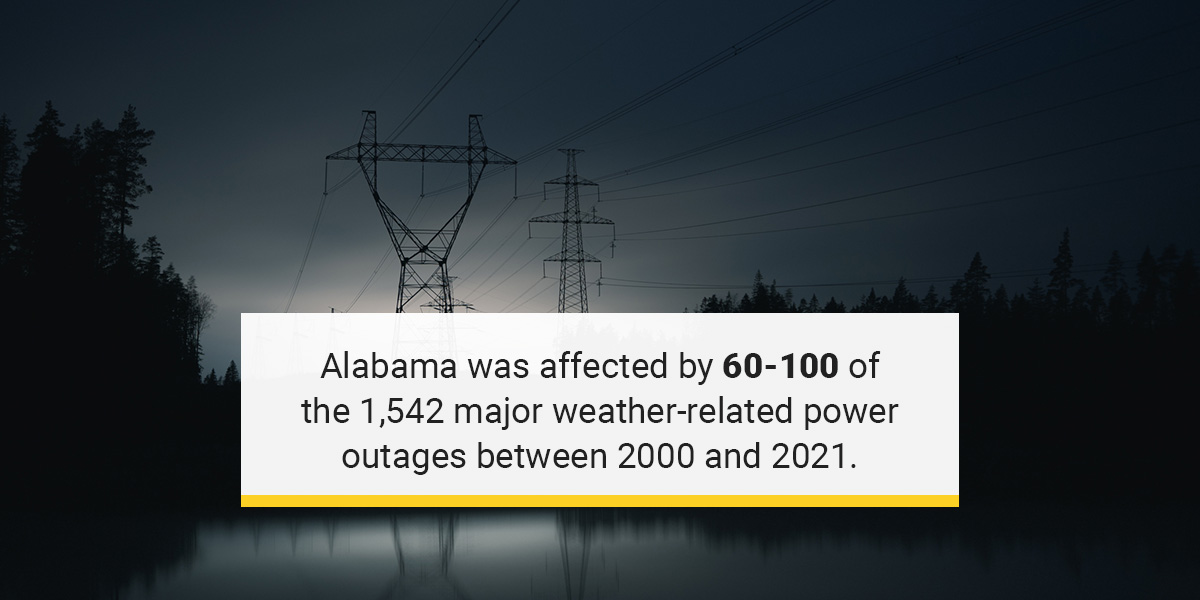
Alabama was affected by 60-100 of the 1,542 major weather-related power outages between 2000 and 2021. These numbers average out to about three to five major outages in the state per year. Additionally, Alabama has experienced more tornadoes in 2023 than any other state so far.
Many people associate tornadoes with the “Tornado Alley” that occupies the Great Plains, including Texas, Kansas, Oklahoma, and Nebraska. However, a lesser-known region called the “Dixie Alley” encompasses southern U.S. states susceptible to severe tornadoes. The Dixie Alley includes Arkansas, Georgia, Louisiana, Mississippi, Tennessee, and of course, Alabama.
Despite not being part of the infamous Tornado Alley, Alabama had 64 tornado reports in 2023. It was followed by Georgia with 37 reports, then Texas and Mississippi with 28. Alabama is the top state for severe weather reports in 2023, totaling 311. Large hail is responsible for 49 of those reports, while the remaining 198 reports come from damaging wind.
January 2023 has been the most active tornado month for Alabama so far. The state broke its own record for the highest number of confirmed tornados with 29 during January alone. All of these tornadoes occurred on January 3, 4, and 12. Alabama also ranked second for large hail and damaging wind reports.
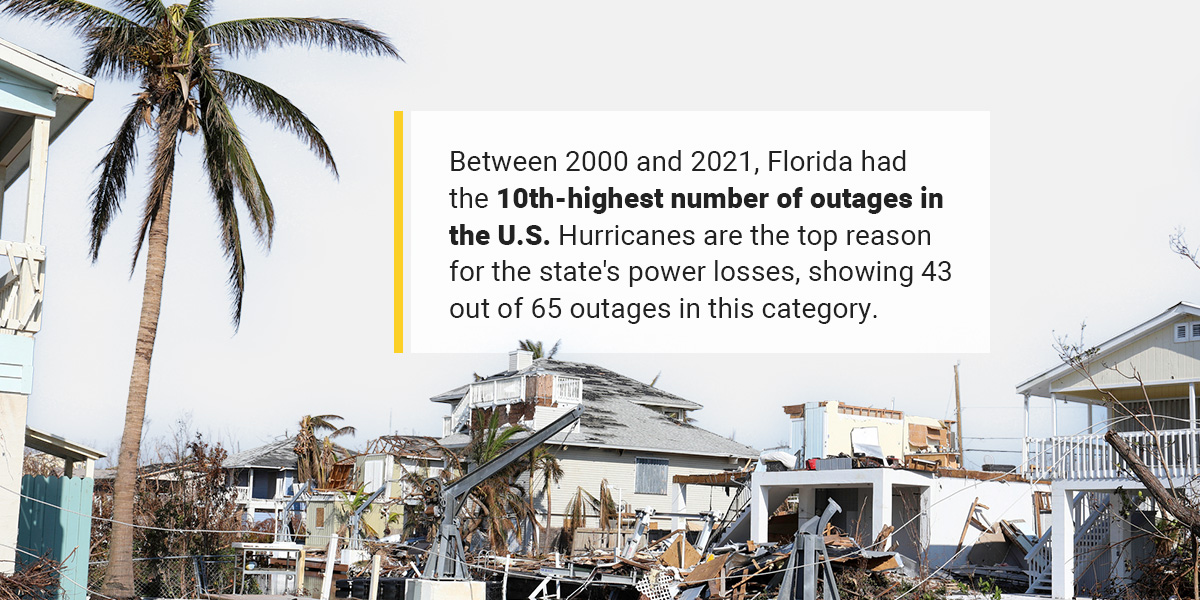
Between 2000 and 2021, Florida had the 10th-highest number of outages in the U.S. Hurricanes are the top reason for the state’s power losses, showing 43 out of 65 outages in this category.
Additionally, a study by the Eaton Corporation power management company in Ohio showed some more shocking statistics of weather-caused outages in Florida. Between 2008 and 2018, no other state saw more of its residents without electricity. Hurricanes and other severe tropical weather caused over 25 million Florida citizens to experience power outages. This decade saw a total of 51,226 minutes without electricity.
Power outages pose numerous risks to public health and safety. For instance, long-term outages often lead to a lack of indoor climate control, which can be dangerous when accompanied by extreme cold or heat. Prolonged outages can compromise refrigeration without an alternative power source, significantly reducing food supply.
Outages can also interfere with access to clean water for people who haven’t stored any themselves. Water purification systems can break down when the power goes out, and water can become unavailable or contaminated. Not to mention people who rely on electricity to power medical devices.
That being said, backup power for educational facilities, hospitals, food and beverage processors, and other institutions is crucial.
Power outages can impact schools and universities in a variety of ways, from compromised class schedules to equipment damage and data loss. Besides providing inhospitable learning environments for students and faculty, outages can cause educational facilities to lose valuable time and money.
A secondary power solution should be available for phone systems, fire alarms, computer networks, food storage systems, and other critical equipment. Furthermore, some educational buildings serve as fallout shelters. They require backup power for emergency lighting to help everyone enter the building safely.
There are also universities with student housing to consider. Students that live in dorms need reliable alternative power to comfortably live on campus until the primary power source is restored.
We’ve thrown plenty of numbers and statistics at you regarding weather-related outages in Florida and Alabama. Now, the question is, what can you do to equip your educational facility for major power outages? Your school should have a detailed emergency plan to prepare for severe storms, including measures like:
In the next few sections, we’ll cover some essential measures to help you prepare for and respond to school power outages.
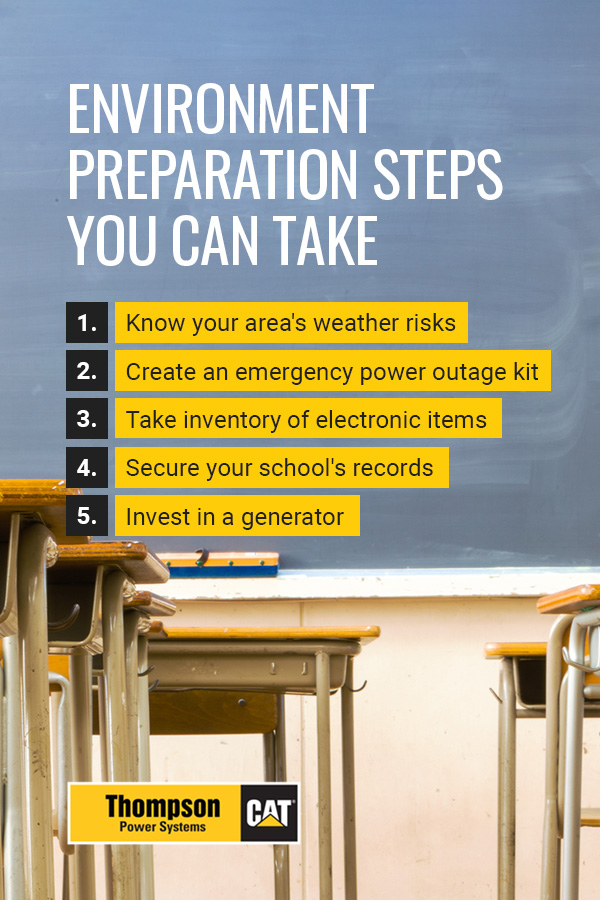
Investing in the proper equipment, resources, and supplies can help prepare your facility for any natural disasters and power outages that might occur. Here are some steps you can take:
Thorough security measures and training are pivotal to keeping students and staff safe during outages. From covering windows and doors to helping students safely evacuate the building, staff members need to know your facility’s emergency plan down to every last detail. Ensure they receive comprehensive training on school power outage protocols.
Equipping your school’s structure before a storm is also important to protect everyone in the building. Below are some measures to help keep faculty and students safe during severe weather events.
School faculty members should be trained in emergency response skills in case a natural disaster occurs. This training program should include first aid, building and area evacuation, shelter, nutrition, and sanitation.
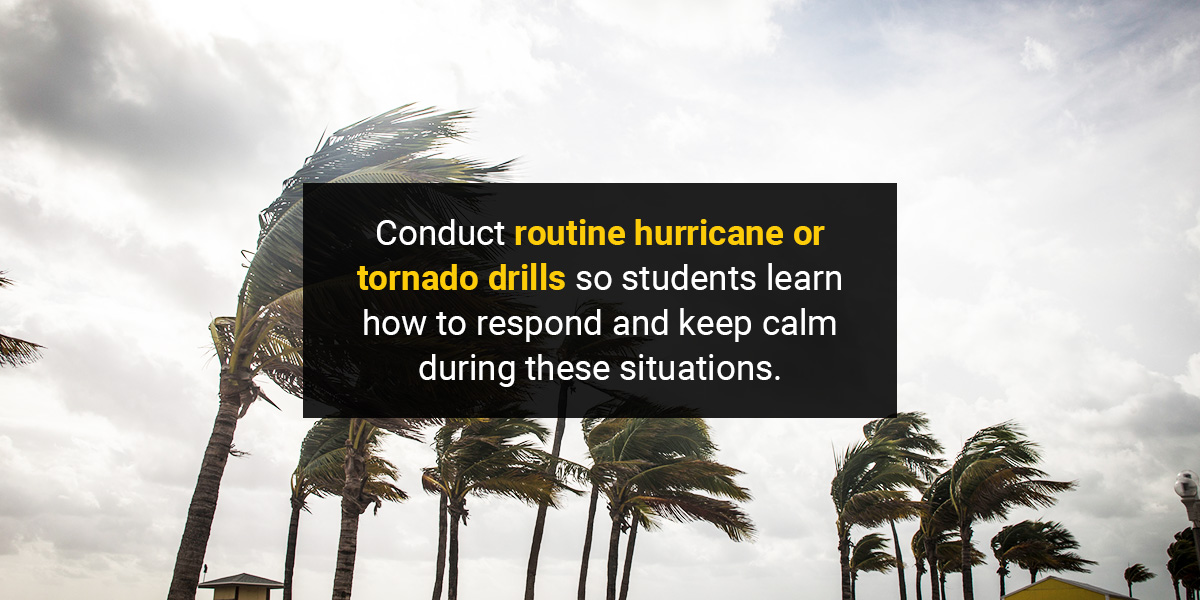
Students should also know what to do when a natural disaster occurs during school hours. Conduct routine hurricane or tornado drills so students learn how to respond and keep calm during these situations.
A storm-proofed school can reduce the damage in the aftermath of a natural disaster. Here are some ways you can secure your building and ground to prepare for a tornado, hurricane, or other phenomenon:
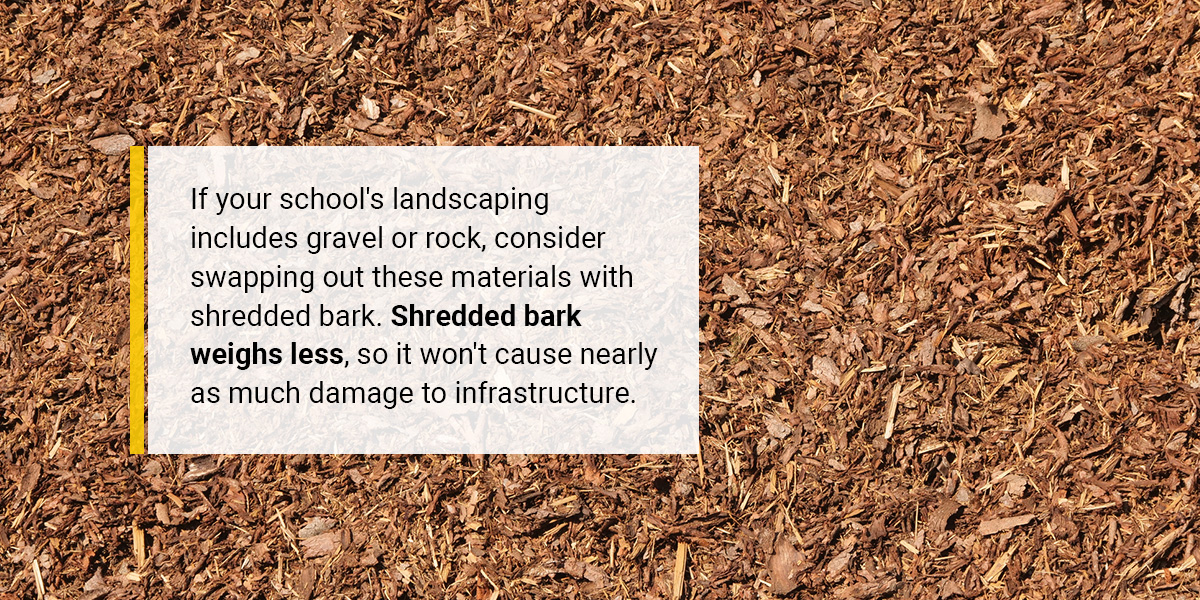
If your campus includes portable offices or classrooms, it’s important to secure them against strong winds. Ask the portable structure manufacturer for detailed specifications about the product, then work with your maintenance team to plan pre-storm measures accordingly.
The ideal course of action would be moving students to a stabler, more permanent structure than a mobile office or classroom, such as a brick or concrete building. However, portable structures can still play a significant role in your disaster recovery plan, especially since they’re simple to install and relocate. While permanent classrooms and offices are being cleaned or repaired after a major storm, mobile classrooms can provide temporary learning spaces.
Remember that large, open spaces — such as gymnasiums, auditoriums, and cafeterias — should not be used to shelter people during a severe weather event. These types of rooms tend to be structurally weak and lack roof support. This makes them vulnerable to collapse, even during weaker tornadoes.
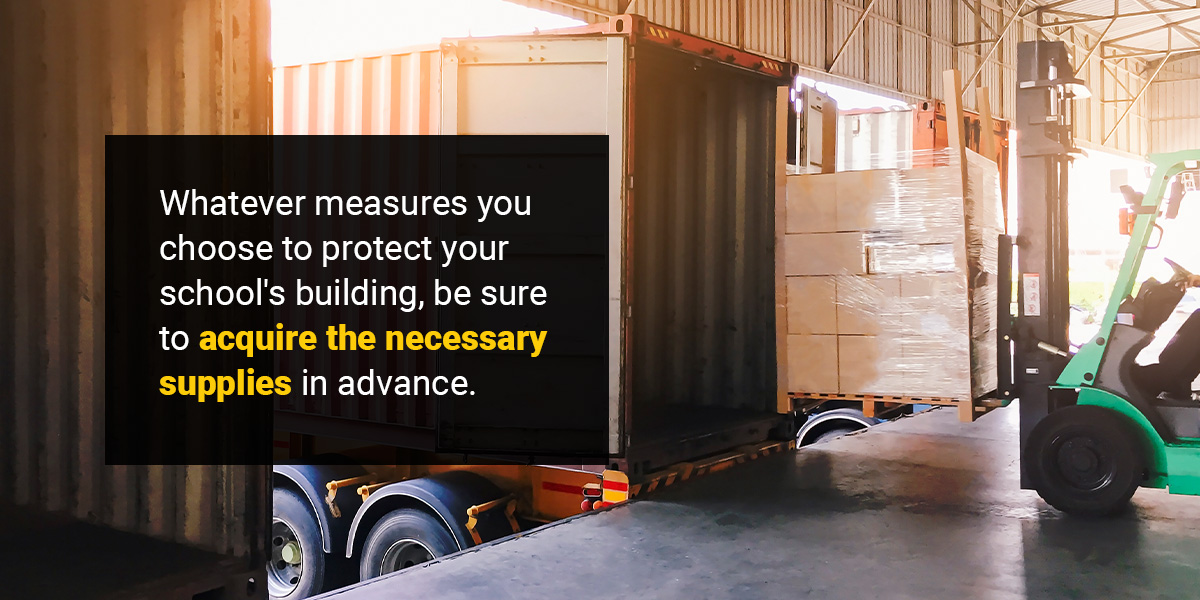
Whatever measures you choose to protect your school’s building, be sure to acquire the necessary supplies in advance. Additionally, fill in your facilities provider on the plan and keep them in the loop about any changes you implement. Communication is key when planning for a natural disaster and power outage.
Some frozen and refrigerated foods — such as meat, milk, eggs, cheese, cooked leftovers, and cut fruits and vegetables — may not be safe to eat after a power outage. Below are some measures you can take to preserve perishable foods during an outage, comply with food requirements, and protect students and staff from foodborne illness.
To prepare for a natural disaster or power outage, you can:
During an outage, you can:
After the outage, be sure to:
You can create a food emergency readiness plan using the Food Facility Power Outage Safety Steps by Environmental Health Services. These steps can provide more detail on what to do with food before, during, and after power outages. Remember — when in doubt, throw it out!
Schools are often legally required to have backup power generators, as they are integral to many fire and life safety systems. The generator should also comply with National Fire Protection Association (NFPA) 110.
Emergency generators must be installed, tested, and maintained according to NFPA 110 guidelines. A properly trained person must oversee routine maintenance, inspection, and operational testing of the emergency generator. Some basic generator maintenance measures include:
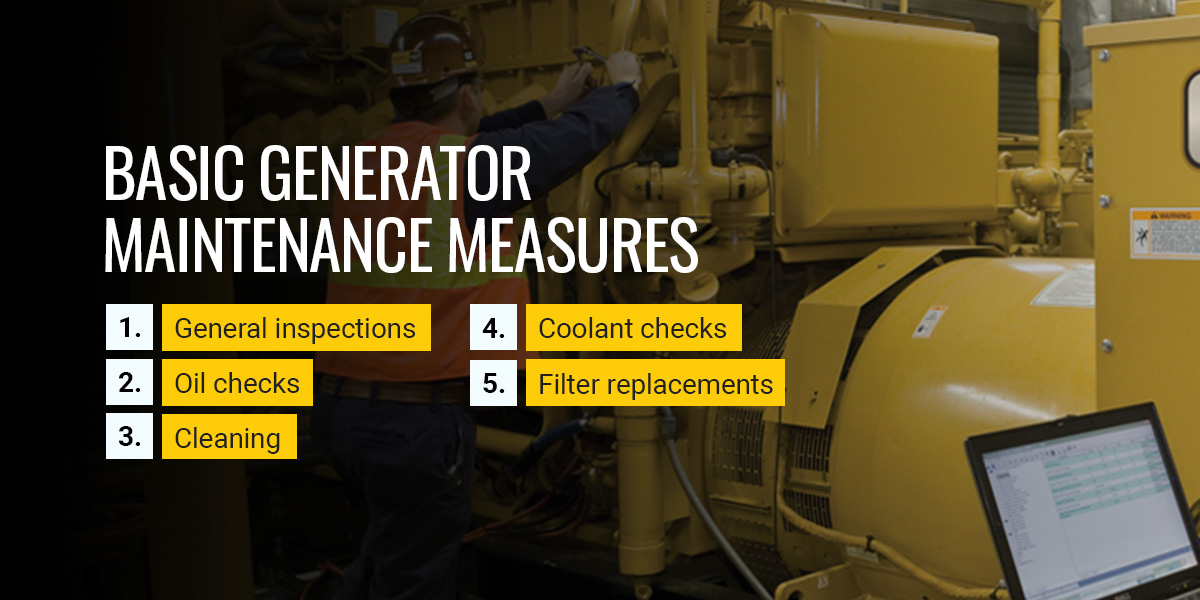
With classrooms, cafeterias, computer equipment, and other factors at stake, educational institutions need high-quality generators to provide sufficient standby power in emergency situations. A generator allows heating, cooling, ventilation, elevators, security, and other critical systems to continue working during outages until the standard power source is restored.
You have a couple of options when choosing an emergency backup generator.
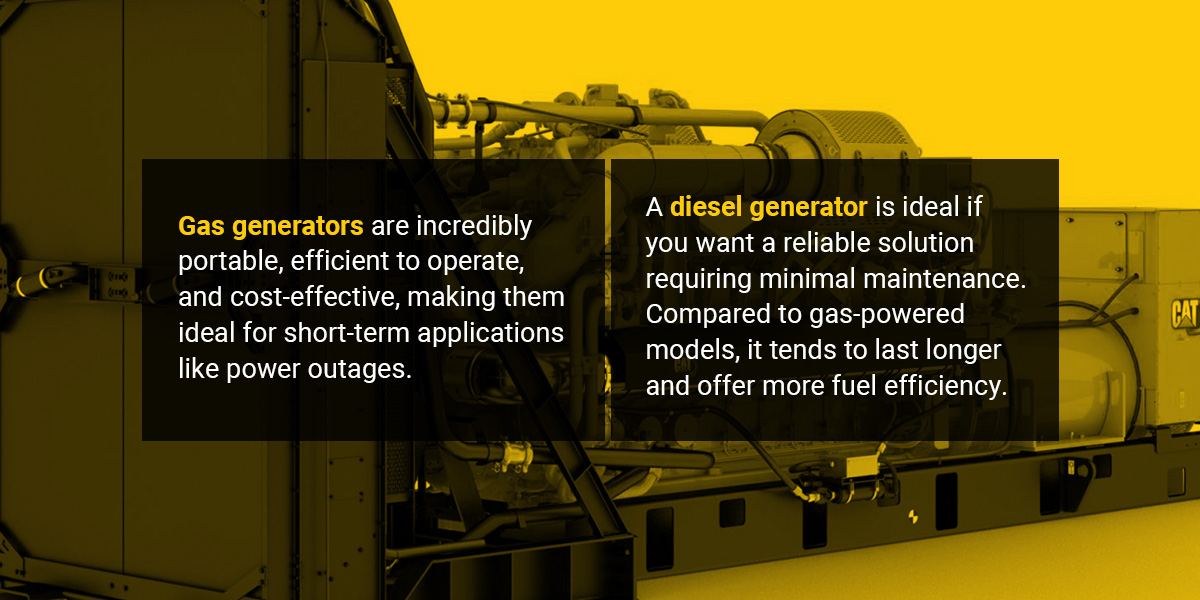
A gasoline generator typically connects to a gas line to produce electricity. It injects gasoline and air through a carburetor. The carburetor compresses the air and gas and creates an ignition, which spins the machine’s rotor and creates an electric current that can power equipment.
A gas generator offers numerous benefits. It’s incredibly portable, efficient to operate, and cost-effective, making it ideal for short-term applications like power outages. Since it runs on gas instead of diesel, its fuel is usually more affordable.
A diesel generator compresses air, then injects diesel fuel into a chamber to generate heat. This heat production triggers the fuel’s ignition, powering the generator and creating an electrical current.
A diesel generator is ideal if you want a reliable solution requiring minimal maintenance. Instead of a carburetor, it uses compression to generate an electrical current. Compared to gas-powered models, it tends to last longer and offer more fuel efficiency. The lack of a carburetor also means you don’t have to worry about the expense of repairing or replacing this part.
If you need Florida or Alabama school backup power, Thompson Power Systems can help you find a solution. We have an extensive inventory of electric power generation systems, including gas-powered, diesel-powered, mobile generators, and more.
Browse our selection of industrial backup generators, then submit a request once you find an ideal solution for your educational facility. We look forward to assisting you!